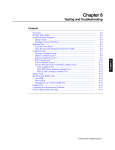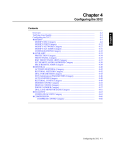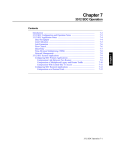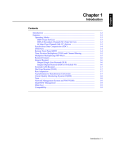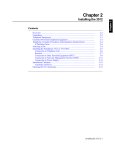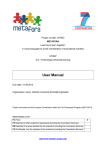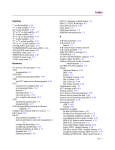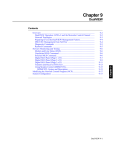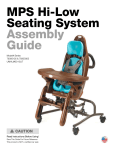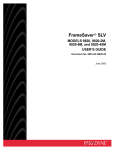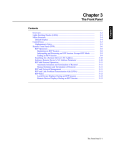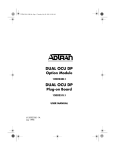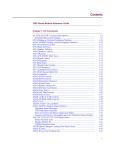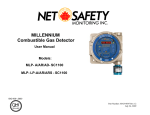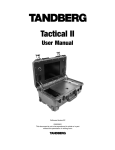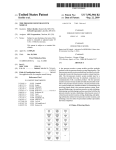Download Tran:3512 DSU/CSU User`s Manual:Ch6:3512 Operation
Transcript
Chapter 6 3512 Operation Introduction .................................................................................................. System Applications ..................................................................................... Operating Modes and Network Management Overview ............................... DDS-I Service .......................................................................................... Transmission Modes: Overview .......................................................... Main Channel Transmission Mode Over Point-to-Point Circuits......... Main Channel Transmission Mode Over Multipoint Circuits ............. Derived Secondary Channel Transmission Mode, Bitstealing ............. Derived Secondary Channel Transmission Mode, Muxed ................... DDS Secondary Channel (DDS-II SC) Services ...................................... DDS-II SC Transmission Service on Point-to-Point Circuits .............. DDS II SC Transmission Service Multipoint Circuits ......................... 64k Clear Channel (64k CC) Service ....................................................... Time-Division Multiplexing (TDM) ............................................................. TDM and Channel Sharing ....................................................................... TDM and Port-to-Channel Mapping ......................................................... Point-to-Point TDM on DDS-I Type Service ....................................... Point-to-Point TDM & Channel Sharing with DDS-I Service ............ Multipoint TDM and Channel Sharing on DDS-II SC Type Service .. Mixed TDM - Channel Sharing Applications ...................................... Multipoint TDM and MP-Mux ................................................................ MP-Mux with Non-interruptive Network Management ...................... MP-Mux with Circuit Consolidation ................................................... MP-Mux with Automatic Channel Rate Configuration ....................... MP-Mux with Rate Adaptation ............................................................ MP-Mux with Mixed TDM and Channel Sharing ................................ TDM and Tail Circuits .............................................................................. Tail Circuit off 3512 TDM Trunk ........................................................ Tail Circuit Off 3512 TDM in Channel Sharing Mode—DDS-I ......... Tail Circuit Off 3512 TDM in Channel Sharing Mode—DDS-II SC... Restoral Operation ........................................................................................ Restoral Timing Considerations ............................................................... Analog Restoral Timing ....................................................................... Digital Restoral Timing ....................................................................... Initiating and Terminating Restoral .......................................................... Integral Analog Dial Restoral ................................................................... SLR Automatic Rate-Negotiation Feature ........................................... Sample SLR Applications .................................................................... Integral Digital Restoral ........................................................................... Integral Digital Dial Restoral ............................................................... Switched-56 and Leased 56k Integral Digital Restoral ....................... External (A/B) Restoral (Analog and Digital) ......................................... External Restoral Tips and Considerations .......................................... External Restoral Sample Applications ............................................... 6-3 6-3 6-3 6-4 6-4 6-5 6-7 6-7 6-9 6-11 6-11 6-12 6-13 6-14 6-14 6-15 6-18 6-18 6-19 6-20 6-21 6-22 6-23 6-24 6-24 6-25 6-26 6-26 6-27 6-27 6-28 6-28 6-28 6-29 6-29 6-30 6-30 6-31 6-34 6-34 6-35 6-36 6-36 6-38 3512 Operation 6-1 Chapter 6 Contents Contents (Continued) Limited Distance Modem (LDM)/Private Wire Applications ...................... LDM Timing Considerations ............................................................... Tail Circuit Considerations .................................................................. LDM Tail Circuits - DDS-I ................................................................... LDM Tail Circuits - DDS-II SC ........................................................... LDM Tail Circuits - 64k ....................................................................... DSU/CSU and Port Timing .......................................................................... DSU Timing Options ................................................................................ Network Timing Option........................................................................ Internal Timing Option ........................................................................ External Timing Option ....................................................................... Port Timing................................................................................................ Synchronous/Internal Timing Option .................................................. Synchronous/External Timing Option ................................................. Synchronous/Station Timing Option ................................................... Asynchronous Data Timing Option ..................................................... 6-2 3512 Operation 6-43 6-43 6-44 6-44 6-45 6-46 6-46 6-46 6-47 6-47 6-48 6-48 6-48 6-49 6-50 6-50 Introduction This chapter describes how to configure the 3512 DSU/CSU to address your application requirements most effectively. Configuring applications requires familiarity with front-panel operation and the menu tree structure. For more information on... Front-panel operation, keys, and displays Configuring the 3512 and 3512 SDC Refer to... Chapter 3, The Front Panel Chapter 4, Configuring the 3512 System Applications This section explains some of the primary system applications of the 3512: • Operating Modes and Network Management Overview • DDS (DDS-I) Services • DDS Secondary Channel (DDS-II SC) Services • Point-to-Point Time Division Multiplexing (TDM) and Channel Sharing • TDM and Port-to-Channel Mapping • Multipoint Time Division Multiplexing (MP-Mux) Operating Modes and Network Management Overview A Motorola 9300 or 9800 Network Management System (NMS) enables you to manage entire networks from a single central site. This is useful for applications that require integrated management of Motorola communication devices (3500, 3512, and 3520 DSU/CSUs, and 326X analog modems, multiplexers, and other system devices). NMS software enables you to: • Configure, activate, and test communication devices from the central site • Gather and display performance data • Track performance problems and evaluate alternate configurations • Define groups of communication devices to facilitate managing large networks The NMS uses the network control channel, which it accesses through the NC IN and NC OUT connectors on a local 3512 rear panel. The level of network management and control is determined by: • Digital service type (DDS-I, DDS-II SC or 64k CC) • Network management mode (Derived Secondary Channel or Normal) • Circuit configuration (point-to-point or multipoint; single or multiple tier) The following section explains how network management is supported with various services, network management modes, and circuit configurations. 3512 Operation 6-3 DDS-I Service This section describes DDS-I type transmission modes, configurations and applications. The 3512 supports DDS-I transmission rates of 2.4 to 56 kbps on point-to-point or multipoint leased digital lines. With DDS-I, there are three primary modes of network management and control: • Main Channel (Normal) • Derived Secondary Channel (BitSteal) • Derived Secondary Channel (Muxed) These modes are independent of the host communications protocol. DTE Con ( MODIFY, MODIFY PORT) options specify the mode. * Transmission Modes: Overview In Main Channel (also known as Normal) mode, network management information is transmitted over the main channel, temporarily interrupting user data. “Normal” mode, despite its name, should be used only when: • Your data terminal equipment (DTEs) must transmit at a full rate—one that exactly equals the line rate • You do not require network management Main channel mode buffers network control commands and network polling data, then transmits them at the full line rate. In Derived Secondary Channel modes, network management information is transmitted through Bitstealing or Multiplexing (known as muxing) over a small, separate part of the total bandwidth, allowing user data to continue without interruption. In derived secondary channel modes, the 3512 uses time division multiplexing (TDM) to maintain the non-interruptive network management channel. This Mode... Bitstealing Muxed Operates on... Point-to-Point Circuits Multipoint Circuits Point-to-Point Circuits Multipoint Circuits And Requires... — The MP-Mux feature and a line rate ≥ 9.6 kbps — The MP-Mux feature and a line rate ≥ 9.6 kbps The following sections describe each of the DDS-I transmission modes in detail. 6-4 3512 Operation Main Channel Transmission Mode Over Point-to-Point Circuits A point-to-point DDS-I application with a Motorola NMS at the local site is shown in Figure 6-1. Network control data uses the NC ports and main channel data uses a DTE port. The DTE port rate and the subscribed line rate are 56 kbps. 56 kbps DTE 56 kbps Unit A 56 kbps Unit B DDS-I 3512 3512 DTE Primary Channel Motorola NMS Figure 6-1. DDS-I Point-to-Point, Main Channel Mode Parameters not specified below may be set to factory default values. Category Parameter MODIFY PORT DTE Con MODIFY DSU Data Rate MODIFY NETWORK NC Address *Where x and y are valid addresses 3512 Unit A Normal 56.0 x* 3512 Unit B Normal 56.0 y* Incoming network control data addressed to the local device is buffered and processed locally. It is not passed out to the DDS-I channel, to prevent unnecessary main-channel interruption. Incoming network control data addressed for remote devices is buffered locally and sent as a single message to the remote device(s) at the DDS-I rate. This causes one interruption to main channel data for the command and subsequent interruptions for responses. If necessary, you can further minimize user-data interruptions by taking remote units off the NMS poll list. (Do not do so unless performance is a problem.) Network management data then interrupts user data only when the unit is specified. Using this strategy in point-to-point configurations, circuit or remote device problems cause Out of Service or Link Down alarms to be sent to the master 3512 and the NMS as it polls the master. You can then take diagnostic action. 3512 Operation 6-5 Using Circuit Assurance and System Status to Monitor Remote Devices In some networks, failures at remote units may not have obvious indicators at the master site. If Circuit Assurance or System Status is enabled in the remote unit, the NMS can get information about the circuit from the local unit. Circuit Assurance and System Status cause the remote unit to send only Idles to the master when there is an error condition. The master can generate an alarm when it receives Idles; for details, refer to Chapter 4. Using the NC Mode Parameter to Avoid Network-Management Delay In multi-tier network management applications, buffering complete messages at the 3512 may cause unacceptable secondary-channel delay due to the effect of buffering at each tier boundary. To address this concern, use the NC Mode=Passthru option, which does not buffer control channel data nor inhibit local data from passing down the DDS line. More interruptions occur since each character is passed independently. Using an External Multiplexer to Avoid Network-Management Delay If there is an external multiplexer on the circuit, a multiplexer DTE port can provide an alternate secondary channel to the remote 3512 or second-tier transmission devices (Figure 6-2). In this configuration, the NMS monitors the local 3512. A second NMS connection to a multiplexer DTE port routes NMS polls to the remote 3512 or second-tier devices. DTE DTE Unit A Unit B 3512 P1 NC P1 3512 NC Multiplexer (a) Retransmission: Off Multiplexer Off (b) Primary Channel Secondary Channel (a) NMS monitors local 3512 (b) Alternate secondary channel to remote 3512 or second-tier device (b) Motorola NMS Figure 6-2. DDS-I Point-to-Point, Network-Managed, Main Channel Mode Parameters not specified below may be set to factory default values. Category MOD IFY DSU MODIFY NETWORK 6-6 3512 Operation Parameter Data Rate NC Retrans Unit A 56.0 Off Unit B 56.0 Off Main Channel Transmission Mode Over Multipoint Circuits In a multipoint application, Main Channel mode is used primarily for host polling (Figure 6-3). The host polls each slave device, and one slave uses the channel at a time, temporarily interrupting user data. You can take remote units off the NMS poll list to minimize interruptions, as described above. In this case, the NMS monitors only the master 3512. NOTE: System Status and CQMS functions do not operate in this configuration. If the master displays alarms, you can test remote devices. In this case, remote 3512s are insensitive to the NMS unless the entire circuit fails. (If so, an Out of Service alarm occurs.) 9.6 kbps Unit A Host 9.6 kbps DDS-I 3512 Unit B Unit B Unit B 3512 3512 3512 DTE DTE DTE 9.6 kbps Motorola NMS Primary Channel Secondary Channel Figure 6-3. DDS-I, Multipoint, Main Channel Mode Parameters not specified below may be set to factory default values. Category MODIFY DSU Parameter Data Rate Unit A 9.6 Unit B 9.6 Derived Secondary Channel Transmission Mode, Bitstealing SDC only Bitstealing transmission is available on point-to-point and multipoint circuits. In Bitstealing mode, the DTE rate is slightly less than the main channel rate, as shown in Table 6-1; framing and secondary channel requirements use a small part of the available bandwidth. On a 3512 SDC, Bitstealing is available only when P3=Direct. (For details, refer to Chapter 4, COMPRESSION category.) * Table 6-1. Port Rates with DDS-1 Bitstealing Mode Line Rate (bps) 2400 4800 9600 19200 56000 64000 Available DTE Port Rate (bps) 2290 4688 9487 19040 55200 62400 3512 Operation 6-7 Point-to-point and multipoint circuits using Bitstealing are shown in Figure 6-4 (A) and (B). If the line rate is 56.0 kbps, the DTE port is allocated 55.2 kbps; framing and control data use the remaining bandwidth. Most synchronous DTEs and devices, such as Motorola statistical multiplexers, can operate at these nonstandard port rates. In this configuration, the 3512s provide a non-interruptive control channel similar to that of DDS-II SC type service. Bitstealing mode is available for single-channel applications at 64.0 kbps or subrates. 55.2 kbps 56 kbps Unit A DDS-I 3512 DTE 55.2 kbps Unit B 3512 DTE Primary Channel Secondary Channel Motorola NMS (A) Point-to-Point Circuit, 3512 in Bitsteal Mode 55.2 kbps 56 kbps Unit A DTE DDS-I 3512 Slave B Slave C 3512 3512 Motorola NMS Primary Channel Secondary Channel 55.2 kbps (B) Multipoint Circuit, 3512 in Bitsteal Mode Figure 6-4. DDS-I Derived Secondary Channel Using Bitstealing Parameters not specified below may be set to factory default values. Category Parameter Point-to-Point Circuit, Figure 6-4(A): MODIFY DSU Data Rate MODIFY PORT DTE Con Multipoint Circuit, Figure 6-4(B): MODIFY DSU Data Rate MODIFY PORT DTE Con MODIFY NETWORK NC Address MODIFY SLV ADDR Slv-A Addr Slv-B Addr *Where x, y, and z are valid addresses 6-8 3512 Operation Unit A Slave B Slave C 56.0 BitSteal 56.0 BitSteal 56.0 BitSteal 56.0 MPM-BitSteal x* y* z* 56.0 56.0 MPS-BitSteal MPS-BitSteal y* z* Derived Secondary Channel Transmission Mode, Muxed Muxed mode provides a derived secondary channel, but maintains standard DTE rates for DTEs that require them. With Muxed mode, you can multiplex applications and data sources on one line, or you can take advantage of favorable digital line tariffs and to obtain unavailable data rates, without the cost of upgrading front-end ports or other DTE equipment. Using Muxed mode this way is known as rate adaptation. For example, with a 3512 is at 56.0 kbps, if an application requires a lower throughput, you can configure the 3512 to operate at the lower rate. Rate adaptation is supported over point-to-point and multipoint DDS-1 type circuits. Figure 6-5 shows the derived secondary channel obtained with Muxed mode. Ports can be configured as channel sharing or time division multiplexing (TDM). SDC only On a 3512 SDC, Muxed mode is available only when P3=Direct. (Refer to Chapter 4.) 19.2 kbps 56 kbps Unit A DDS-I 3512 DTE 19.2 kbps Unit B 3512 DTE Primary Channel Secondary Channel Motorola NMS (A) Point-to-Point Derived Secondary Channel Circuit, 3512 in Muxed Mode 9.6 kbps Unit A DDS-I 56 kbps 3512 DTE Slave B 3512 Motorola NMS Primary Channel Secondary Channel Slave C 3512 Port: 1 DTE 9.6 kbps 1 DTE 9.6 kbps (B) Multipoint Derived Secondary Channel Circuit, 3512 in Muxed Mode Figure 6-5. DDS-I Derived Secondary Channel Using Multiplexing 3512 Operation 6-9 Parameters not specified below may be set to factory default values. Category Parameter Point-to-Point Circuit, Figure 6-5 (A): MODIFY DSU Data Rate Ch1 Rate MODIFY PORT DTE Con Multipoint Circuit, Figure 6-5 (B): MODIFY DSU Data Rate Ch1 Rate MODIFY PORT DTE Con MODIFY NETWORK NC Address MODIFY SLV ADDR Slv-B Addr Slv-C Addr *Where x, y, and z are valid addresses 3512 Unit A Slave B Slave C 56.0 56.0 56.0 19.2 19.2 19.2 56.0 9.6 MPM-Mux x* y* z* 56.0 9.6 MPS-Mux y* 56.0 9.6 MPS-Mux z* In Muxed mode, ports can be set to any standard rate. This mode supports up to four DTE ports; Table 6-2 shows the maximum rates. Table 6-2. Maximum Aggregate Transmission Rates in Muxed Mode Aggregate Port Rate (kbps) 1.2 4.5 9.0 18.0 55.2 62.4 6-10 3512 Operation Aggregate Line Rate (kbps) 2.4 4.8 9.6 19.2 56.0 64.0 DDS Secondary Channel (DDS-II SC) Services With DDS-II SC type service, the carrier provides bandwidth, over the local loop to the digital serving office, for a non-interruptive network management channel. This type of secondary channel is provided on point-to-point and multipoint circuits. Maximum channel and line rates for DDS-II SC type services are shown in Table 6-3. (Data framing and carrier control code requirements account for the differences between aggregate rates and the sums of the primary and secondary rates.) Table 6-3. Transmission Channel Rates with DDS-II SC Type Services Primary Channel Secondary Channel Aggregate Line (kbps) (bps) (kbps) 2.4 133 3.2 4.8 266 6.4 9.6 533 12.8 19.2 1066 25.6 56.0 2667 72.0 NOTE: Some data rates may be unavailable in certain digital serving areas or configurations. Consult your local carrier for details DDS-II SC Transmission Service on Point-to-Point Circuits A DDS-II SC 56-kbps point-to-point circuit is shown in Figure 6-6. An NMS uses the secondary channel for full-time, non-interruptive circuit and device monitoring. In multi-tier configurations, the secondary channel can be connected from the remote 3512 to second-tier network-managed Motorola modems and DSUs. 56 kbps DTE Unit A 72 kbps DDS-II SC 3512 Unit B 3512 56 kbps DTE Primary Channel Secondary Channel Motorola NMS Figure 6-6. DDS-II SC Point-to-Point Circuit Parameters not specified below may be set to factory default values. Category MODIFY DSU Parameter Opmode Data Rate Unit A DDS2 56.0 Unit B DDS2 56.0 3512 Operation 6-11 DDS-II SC mode may be used in conjunction with a muxed DTE configuration (DTE Con=Muxed). TDM or channel sharing may be used on up to four ports. A DDS-II SC 56-kbps point-to-point circuit with the DTE set at 19.2 kbps is shown in Figure 6-7. Rate adaptation is used to take advantage of 56-kbps tariffs or to obtain unavailable data rates without upgrade costs. 19.2 kbps 72 kbps Unit A Unit B 19.2 kbps DDS-II SC 3512 DTE DTE 3512 Primary Channel Secondary Channel Motorola NMS Figure 6-7. DDS-II SC Point-to-Point (Muxed) Parameters not specified below may be set to factory default values. Category MODIFY DSU Parameter Opmode Data Rate Ch1 Rate DTE Con MODIFY PORT 3512 Unit A DDS2 56.0 19.2 Muxed 3512 Unit B DDS2 56.0 19.2 Muxed DDS II SC Transmission Service Multipoint Circuits The 3512 supports a multipoint DDS-II SC circuit in Main Channel mode, as shown in Figure 6-8. This way, you obtain standard DTE rates and non-interruptive network management. This is similar to the DDS-I circuit shown in Figure 6-4 (B). As with point-to-point multi-tier configurations, the secondary channel can be routed to second-tier devices. Rate adaptation is not supported with this type circuit. 9.6 kbps 12.8 kbps Unit A 3512 DTE DDS-II SC Motorola NMS Primary Channel Secondary Channel Unit B Unit D 3512 3512 3512 DTE DTE DTE 9.6 kbps Figure 6-8. DDS-II SC Multipoint Circuit 6-12 3512 Operation Unit C Parameters not specified below may be set to factory default values. Category MODIFY DSU Parameter Opmode Data Rate Unit A DDS2 9.6 Unit B, C, D DDS2 9.6 NOTE: In DDS-II SC applications at 56 kbps, some data patterns can cause secondary-channel errors. DDS-II service specifies that data must contain a certain density of 1s; long strings of consecutive 0s are not allowed. If necessary, the network alters user data to manage 1s density. To prevent this, the 3512 uses the DDS-II SC bit to insert 1s as needed, which may affect secondary-channel performance. Because of the need to manage 1s density, 56 kbps DDS-II SC applications are not supported. 64k Clear Channel (64k CC) Service The 3512 supports the 64 kbps Clear Channel (64k CC) service, as shown in Figure 6-8. This service, available for point-to-point circuits, allows data transmission at a line or port rate of 64 kbps. With 64k CC, network management is available only in the non-interruptive modes (bitstealing and muxed); the bandwidth available to user applications is approximately 63.2 kbps. 64 kbps 64 kbps 64 kbps 64.0 DTE 3512 DTE 3512 Primary Line Figure 6-9. 64kbps Clear Channel Circuit Parameters not specified below may be set to factory default values. Category MODIFY DSU Parameter Opmode Unit A 64k CC Unit B 64k CC 3512 Operation 6-13 Time-Division Multiplexing (TDM) This section describes time-division multiplexing (TDM), which is available with DDS-I, DDS-II SC, and 64k CC service, and features that TDM supports: • Channel sharing • Port-to-channel mapping • Multipoint multiplexing (MP-Mux) The next section shows TDM tail circuits (private-wire, point-to-point applications). TDM and Channel Sharing With point-to-point TDM, the 3512 communicates with a mix of DTEs operating at different transmission speeds. The DTEs might be multiple ports from a single host computer or front-end processor (FEP); multiple low-speed terminals; or another DCE device (tail circuit). A multiplexer on the other end of the line divides the transmissions into component signals and sends them to the terminal ports. NOTE: TDM uses a small part of the main channel data rate for framing and control functions. TDM operates by scanning the unit’s device ports, starting with Port 1. TDM allocates time slots, called channels, on the main channel to each DTE, interleaving slots to continuously transmit over the line at a rate up to the sum of the separate terminal rates. The receiving 3512 distributes the data, by time slot, to its ports. The 3512 also provides channel sharing. Channel sharing is sometimes known as port sharing, or a “modem” sharing unit (MSU). The 3512: • Supports TDM and channel sharing in a number of circuit configurations • Operates as a single or multiple channel unit Channel sharing allocates the bandwidth of a TDM channel among some or all of the 3512's ports. You can configure port rates up to 56 kbps (depending on the line rate and operating mode). Use channel sharing when you have multiple DTEs polled by one application, in point-to-point or multipoint circuits. In a point-to-point circuit, channel sharing may be used with: • Interruptive network management • Non-interruptive bitstealing • Rate adaptation One channel sharing setup can be configured on a 3512. 6-14 3512 Operation TDM and Port-to-Channel Mapping Assigning DTE ports to TDM channels forms a port-to-channel map, which specifies how the 3512 handles the DTEs’ data. In port-to-channel mapping: • Each 3512 physical port corresponds to a DTE connector • Each 3512 logical channel corresponds to a TDM time slot Assigning multiple DTE ports to one TDM channel forms a channel sharing unit. NOTE: TDM Channels 5 through 8 are not shown in this manual, although you can assign ports to them on the 3512, for compatibility with 3520 DSU/CSUs. 3520 3512 Figure 6-10 shows how multiplexing uses port-to-channel mapping assignments: • In Figure 6-10(A), applications A through D assign ports to like-numbered channels (Port 1 is assigned to Channel 1, and so on) • In Figure 6-10(B), at the remote site, applications A through D assign ports to different channels (Port 1 is assigned to Channel 2, and so on) Port Host Computer or FEP A B C D 1 2 3 4 Channel Channel 1 2 3 4 1 2 3 4 3512 Ports: 1 2 3 4 Channels: 1 2 3 4 (Port to Channel Map) Port A B C D 1 2 3 4 3512 Co-located Terminals Ports: 1 2 3 4 Channels: 1 2 3 4 (Port to Channel Map) (A) Port-to-Channel Mapping with Same Assignments Port Host Computer or FEP A B C D Channel 1 2 3 4 1 2 3 4 3512 Ports: 1 2 3 4 Channels: 1 2 3 4 (Port to Channel Map) Channel 2 1 3 4 1 2 3 4 3512 Port B A C D Co-located Terminals Ports: 1 2 3 4 Channels: 2 1 3 4 (Port to Channel Map) (B) Port-to-Channel Mapping with Different Assignments Figure 6-10. Port-to-Channel Mapping Assignments Sample P-to-Ch options for this configuration are shown in the figure. The map lets you establish virtual point-to-point links on a multipoint circuit using MP-Mux. MP-MUX 3512 Operation 6-15 The 3512 uses port-to-channel mapping for circuit consolidation, as follows: • Figure 6-11 (A) shows a central-site 4-port 3512 and remote 1-port devices establishing multiple virtual point-to-point circuits • Figure 6-11 (B) shows polling on Channel 1 to both sites and slaves; and on Channels 2, 3 and 4, to one site Port Channel A 1 1 B 2 2 C 3 3 D 4 4 56 kbps DDS-I Service 1-Port 3512 1-Port 3512 Ch 2 B Ports: 1 2 3 4 Channels: 1 2 3 4 A Ch 1 1-Port 3512 1-Port 3512 Port 1 Port 1 D Ch 3 C Port 1 (A) Point-to-Point Circuit Consolidation Using Multiple 1-Port 3512s at Remote Sites Port Channel A 1 1 B 2 2 56 kbps DDS-I Service C 3 3 1-Port 3512 D 4 4 Ch 1 Port 1 Ports: 1 2 3 4 Channels: 1 2 3 4 4-Port 3512 Channel Port 1 1 2 2 3 3 4 4 (B) Multipoint Circuit Consolidation Using 1- and 4-Port 3512s at Remote Sites Figure 6-11. Port-to-Channel Mapping with Circuit Consolidation 6-16 3512 Operation A B C D Ch 4 Port 1 Sample P-to-Ch parameters for this configuration are shown in the figure. NOTES: 3520 1) You can map Channels 1 - 8 to ports, to accommodate 8-channel 3520s. 3512 2) In muxed mode without channel sharing, you may map any combination of channel numbers to the 3512's ports; you may specify each channel only once. 3) With external (A/B) restoral (on Port 2), to use channel sharing you must map Port 2 to Channel 2. The 3512 defaults to 0 bandwidth on Channel 2. 4) With channel sharing, Channel 2 cannot be used in a port-to-channel map. MP-MUX 5) In MP-Mux mode, the master automatically configures slaves’ channel rates to equal its own. It does so during the training sequence. You may assign bandwidth to channels for which no port assignment has been made. You may assign more channels than there are ports in the device (for example, on a 4-port unit, you may assign bandwidth to any four of the eight channels). 6) Assign unused ports to Channel 0. Table 6-4 shows the relationship between TDM applications, transmission services provided, and the circuits they support. Table 6-4. TDM and Channel Sharing Applications Application TDM Channel Sharing (Normal mode) Channel Sharing with Rate Adaptation Channel Sharing with Bitstealing Mixed TDM-Channel Sharing Service DDS-I DDS-II SC, 64k CC DDS-I DDS-II SC, 64k CC DDS-I DDS-II SC, 64k CC DDS-I DDS-II SC, 64k CC DDS-I DDS-II SC, 64k CC Circuit Available Point-to-Point, Multipoint Point-to-Point Point-to-Point, Multipoint Point-to-Point, Multipoint Point-to-Point, Multipoint Point-to-Point Point-to-Point, Multipoint Point-to-Point Point-to-Point, Multipoint Point-to-Point 3512 Operation 6-17 Point-to-Point TDM on DDS-I Type Service A 4-port 3512 with TDM in Muxed mode and 56-kbps DDS-I type service is shown in Figure 6-12. With this service, the 3512 offers aggregate port rates up to 55.2 kbps, whether or not the derived secondary channel is required for network management. All ports support synchronous rates to 48 kbps and asynchronous rates to 19.2 kbps, except 16.8 kbps. Synchronous and asynchronous data can be mixed. Any port can be configured for either EIA/TIA 232-D or V.35 interfaces. The available rates are the same with DDS-I and DDS-II SC type services. DDS-II SC with TDM provides no advantage over DDS-I, since a non-interruptive management channel is provided in either case. 1 56 kbps Unit A DTE 3512 4 1 Unit B DDS-I DTE 3512 4 DTE DTE Primary Channel Secondary Channel Motorola NMS Figure 6-12. Point-to-Point TDM, DDS-I Type Service Parameters not specified below may be set to factory default values. Category MODIFY DSU Parameter Data Rate CHn Rate DTE Con MODIFY PORT Unit A 56.0 As appropriate Muxed Unit B 56.0 As appropriate Muxed Point-to-Point TDM & Channel Sharing with DDS-I Service The 3512 supports channel sharing applications with contention controlled by the host communication protocol. One to four DTEs can contend for the assigned channel (2.4, 4.8, 9.6, 19.2, or 56 kbps). Figure 6-13 shows point-to-point channel sharing in. Since all remote DTEs share one channel, the port-to-channel map is 1111. Port 1 Port 1 DTE Unit A Unit B DTE DDS-I 56 kbps 3512 3512 DTE Port 4 Motorola NMS Primary Channel Secondary Channel Figure 6-13. Point-to-Point TDM with Channel Sharing, DDS-I 6-18 3512 Operation Parameters not specified below may be set to factory default values. Category MODIFY DSU Parameter Unit A Data Rate 56.0 Ch1 Rate As appropriate P-to-Ch 1234* MODIFY PORT DTE Con Muxed *Local Ports 2, 3, and 4 are not used in the example. Unit B 56.0 As appropriate 1111 Muxed Figure 6-14 shows multipoint channel sharing on DDS-I service. Unit A Port 1 DDS-I 56 kbps DTE 3512 Unit D Unit B 3512 3512 Unit C 3512 Motorola NMS Primary Channel Secondary Channel Port: DTE DTE 1 4 DTE Port: DTE DTE 1 4 DTE 1 4 Figure 6-14. Channel Sharing with DDS-I, Multipoint Parameters not specified below may be set to factory default values. Category MODIFY DSU MODIFY PORT Parameter Data Rate Ch1 Rate P-to-Ch DTE Con Unit A 56.0 As appropriate 1234 Muxed Unit B, C, D 56.0 As appropriate 1111 Muxed Multipoint TDM and Channel Sharing on DDS-II SC Type Service With a carrier-provided secondary channel service, port rates to 56 kbps are supported with non-interruptive network management over a point-to-point circuit. Line rates up to 19.2 kbps are supported over multipoint circuits. Figure 6-15 shows multipoint channel sharing with DDS-II SC type service. 3512 Operation 6-19 9.6 kbps Port 1 12.8 kbps Unit A DDS-II SC 3512 DTE Unit B Unit D 3512 3512 Unit C Port: 1 4 1 4 DTE DTE 3512 DTE Motorola NMS DTE Primary Channel Secondary Channel 1 4 DTE DTE Figure 6-15. Channel Sharing with DDS-II, Multipoint Parameters not specified below may be set to factory default values. Category MODIFY DSU Parameter Opmode Data Rate P-to-Ch Unit A DDS2 9.6 1234 Unit B, C, D DDS2 9.6 1111 Mixed TDM - Channel Sharing Applications Port-to-channel mapping lets you assign multiple DTE ports to one TDM channel. A typical application has a host port polling several remote terminals. Some DTE ports may be muxed and others sharing channels. Figure 6-16 shows point-to-point mixed TDM-channel sharing, where both 3512s have multiple DTEs. The remote DTEs on Ports 1 through 3 share Channel 1. The remote DTE on Port 4 uses Channel 2 to local Port 2; other channels are not used in this application. Here, only one terminal (port) can access the shared channel at any one time. When terminals contend, priority is given to the lowest-numbered port. DTEs Channel-Sharing Unit Port 9.6 2.4 kbps Host Computer or FEP 1 2 3 4 Channel Channel 1 2 3 4 Unit A DDS-I 19.2 kbps Port 1 2 3 1 2 4 Unit B Ports: 1 2 3 4 Ports: 1 2 3 4 TDM Channels: 1 2 3 4 TDM Channels: 1 1 1 2 (Port to Channel Map) Figure 6-16. Mixed TDM-Channel Sharing Application 6-20 3512 Operation 3 Polled Terminals Sharing Channel 1 DTE Parameters not specified below may be set to factory default values. Category MODIFY DSU MODIFY PORT Parameter Data Rate Ch1 Rate Ch2 Rate P-to-Ch DTE Con Unit A 19.2 9.6 2.4 1234 Muxed Unit B 19.2 9.6 2.4 1112 Muxed Multipoint TDM and MP-Mux MP-Mux extends the 3512’s multiplex features to enable you to operate several multipoint and point-to-point applications on one multipoint circuit. MP-MUX An MP-Mux network consists of one master (control) DSU/CSU and a number of slave (tributary) DSU/CSUs. Master and slave devices are connected by multipoint junction units (MJUs) within the digital network. Devices transmit as follows: • The master multiplexes data from its DTEs, and transmits it over the DDS line to the MJU. The MJU broadcasts to the slaves. The slaves demultiplex the data to the appropriate DTE ports. • Each slave multiplexes data from its DTEs, and transmits it over the DDS line to the MJU. The MJU combines the data and sends it over the DDS line to the master. The master demultiplexes the data and sends it to the appropriate ports. Up to 20 slaves can be attached to one master 3512. A maximum of 64 DTEs can be connected in a multipoint application. MP-Mux is supported on DDS-I type service only, in two operating modes: • Bitstealing: single channel with non-interruptive network control channel • Muxed: multi-channel with non-interruptive network control channel 3512 Operation 6-21 MP-Mux with Non-interruptive Network Management MP-Mux allows non-interruptive network management of DDS-I multipoint circuits. Using a bitstealing mode or MP-Muxed rate adaptation provides the bulk of available bandwidth to a multipoint application while reserving a small portion for network management. Figure 6-17 shows a multipoint application with noninterruptive network management. To 55.2 kbps Unit A DDS-I 56 kbps 3512 Host Unit B Unit C Unit D 3512 3512 3512 To 55.2 kbps To 55.2 kbps To 55.2 kbps Motorola NMS Primary Channel Non-Interruptive Network Management Channel Figure 6-17. MP-Mux Application with Non-interruptive Network Management Parameters not specified below may be set to factory default values. Category MODIFY DSU MODIFY PORT 6-22 3512 Operation Parameter Data Rate Ch1 Rate DTE Con Unit A 56.0 As appropriate MPM-Mux or MPM BitSteal Unit B, C, D 56.0 As appropriate MPS-Mux or MPS-BitSteal MP-Mux with Circuit Consolidation Circuit consolidation lets you save local access charges by installing a single high-speed multiplexed DDS-I line from the central site to the service provider. A multi-port, multiplexed master 3512 routes data through the carrier office. You can configure point-to-point and multipoint applications on the same circuit. Slaves demultiplex the data at remote sites. Non-interruptive network management is available. Figure 6-18 illustrates point-to-point circuit consolidation, and Figure 6-19 shows multipoint circuit consolidation, using MP-Mux 3512s. Sample P-to-Ch parameters for these applications are shown in the figures. 9.6 kbps per Channel Host A B C D E 3520 8-Port MP TDM 1-1 2-2 3-3 4-4 5-5 DDS-I 56 kbps Port-to-Channel Map Application: Rate: Port-to-Channel Map: 3512 3512 3512 A C E 9.6 1 9.6 3 3512 B D 9.6 Motorola NMS 9.6 5 3512 1-Port Slave 3512s 9.6 2 4 Primary Channel Non-Interruptive Network Management Channel Figure 6-18. MP-Mux for Circuit Consolidation on Multiple Point-to-Point Circuits A Host Motorola NMS B DDS-1 56 kbps 3512 Master 3512 Slave A Application: Port-to-Channel Map: A 1 3512 Slave B A 1 3512 Slave C 3512 Slave D B B 2 2 Primary Channel non-interruptive Network Management Channel Figure 6-19. MP-Mux for Circuit Consolidation on Multiple Multipoint Circuits 3512 Operation 6-23 MP-Mux with Automatic Channel Rate Configuration With automatic rate configuration, the master device “trains” remote slaves as follows: once the master's channel rates have been configured, the master transmits the rates to slaves. Slaves compare their settings with those from the master, and if necessary, modify their configuration to match the master's. This is particularly useful in a circuit consolidation application. With a four-channel master 3512 at a central site and one-channel remote slave 3512s, transmitting configuration data from the master saves configuration time, and ensures that the data paths are properly configured. NOTE: For successful training, the line rates and Opmode must be set to match the service. MP-Mux with Rate Adaptation MP-Mux provides rate adaptation, which lets the 3512 adapt from a higher line rate to a lower DTE port rate, providing the cost savings of higher-speed digital service. Rate adaptation also supports DTE port rates not available from DDS-I type service, enabling you to make rate upgrades without service upgrade costs. Figure 6-20 shows an example. 19.2 kbps DDS-I 56 kbps 3512 Master Host Motorola NMS Slave B 3512 Slave C 3512 Slave D 3512 19.2 kbps 19.2 kbps 19.2 kbps Primary Channel non-interruptive Network Management Channel Figure 6-20. MP-Mux for Rate Adaptation over DDS-I Multipoint Circuits Parameters not specified below may be set to factory default values. Category MODIFY DSU Parameter Data Rate Ch1 Rate MODIFY PORT DTE Con MODIFY NETWORK NC Address MODIFYSLV ADDR Slv-A Addr Slv-B-Addr Slv-C Addr 6-24 3512 Operation Unit A 56.0 19.2 MPM-Mux x y z Slave B 56.0 19.2 MPS-Mux x Slave C 56.0 19.2 MPS-Mux y Slave D 56.0 19.2 MPS-Mux z MP-Mux with Mixed TDM and Channel Sharing Figure 6-21 shows an MP-Mux, mixed TDM - channel sharing environment, with four applications, P, Q, R, and S: • P, a multipoint application extending to Remote Sites 1 and 2, uses Channel 1 — At Site 1, DTEs on Ports 1 and 2 share Channel 1 — At Site 2, a DTE is on 3512 Port 3 • Q, a point-to-point application extending to Remote Site 1, uses Channel 2 • R, a multipoint application extending to Remote Sites 2 and 3, uses Channel 3 — At Site 2, DTEs on Ports 1 and 2 share Channel 3 — At Site 3, DTEs on Ports 1 and 2 share Channel 3 • S, a multipoint application extending to Sites 1 and 2, uses Channel 4 — At Site 1, a DTE is on Port 4 — At Site 2, a DTE is on Port 4 P Q R S Unit A Channel-Sharing Unit DDS-I 56 kbps 4-port 3512 Ports: 1 2 3 4 TDM Channels: 1 2 3 4 (Port to Channel Map) P P 4-port 3512 Site 1 - Unit B Channel-Sharing Unit Q S R R 4-port 3512 Site 2 - Unit C Channel-Sharing Unit Primary Channel Non-Interruptive Network Management Channel 4-port 3512 Ports: 1 2 3 4 TDM Channels: 1 1 2 4 (Port to Channel Map) P Ports: 1 2 3 4 TDM Channels: 3 3 1 4 (Port to Channel Map) S R R Ports: 1 2 3 4 TDM Channels: 3 3 0 0 (Port to Channel Map) Site 3 - Unit D Figure 6-21. MP-Mux for Mixed TDM-Channel Sharing Applications Parameters not specified below may be set to factory default values. Category MODIFY DSU MODIFY PORT MODIFY NETWORK MODIFY SLV ADDR Parameter Data Rate Chn Rate DTE Con P-to-CH NC Address Slv-A Addr Slv-B-Addr Slv-C Addr Unit A 56.0 As needed MPM-Mux Slave B Slave C 56.0 56.0 As needed As needed MPS-Mux MPS-Mux [shown in figure] x y Slave D 56.0 As needed MPS-Mux z x y z 3512 Operation 6-25 TDM and Tail Circuits Tail Circuit off 3512 TDM Trunk The 3512 TDM supports analog and digital tail circuit applications as shown in Figure 6-22. Timing buffers for each port accommodate phase differences between tiers. Inband signaling with DTEs also supported. TDM’s derived secondary channel (for use with DDS-I type services) supports non-interruptive network management. Tail circuits can be private-wire, limited-distance circuits. For details on tail circuit timing, refer to “DSU/CSU and Port Timing.” With a tail circuit from one digital network to another, occasional data errors may occur: when each 3512 derives timing from its digital network and the two networks are not synchronized, slight variations accumulate to cause slips. In general, digital circuits from one service provider with one master clock do not incur slips. The level of network management supported in second-tier devices depends on the service type and the tail circuit configuration. Not shown is the 3512 TDM operating with DDS-II SC type service over the trunk and digital tail circuits. Non-interruptive network management is supported in pointto-point and multipoint tail circuits. The tail circuits can be private-wire, limiteddistance circuits. NOTE: Second-tier 3512s set to DDS-II SC mode cannot use external-timing options. Slips occur unless the first and second tier services have a common clock source. DTE Port 1 1 Unit A Unit B DDS-I 56 kbps DTE 4 3512 2 3512 Analog Service Modem 3512 Digital Service 3 DTE Motorola NMS Primary Channel Secondary Channel Crossover Cable 4 DTE Port-to-Channel Map: 1 Figure 6-22. Tail Circuit Off 3512 TDM Parameters not specified below may be set to factory default values. Category MODIFY DSU MODIFY PORT 6-26 3512 Operation Parameter Data Rate Chn Rate DTE Con P-to-CH Unit A Unit B 56.0 56.0 As needed As needed Muxed Muxed [shown in figure] 2 3 4 Tail Circuit Off 3512 TDM in Channel Sharing Mode—DDS-I The 3512 TDM in channel sharing mode supports tail circuit applications (Figure 6-23). When used with a Motorola NMS, network management commands are data-interruptive. The maximum port rate is 56 kbps. For details on tail circuit timing, refer to “DSU/CSU and Port Timing.” Port 1 DTE 1 DDS-I 56 kbps 3512 2 3512 Analog Service Modem 3512 Digital Service 3 DTE Motorola NMS Primary Channel Secondary Channel Crossover Cable 4 DTE Port-to-Channel Map: 1 1 1 1 Figure 6-23. Tail Circuit Off 3512 TDM, Channel Sharing Mode–DDS-I Parameter options for the setup in Figure 6-23 are the same as those for Figure 6-22, except for P-to-CH, which is 1111. Tail Circuit Off 3512 TDM in Channel Sharing Mode—DDS-II SC With DDS-II SC type service, the carrier provides a secondary channel for network management. The maximum port rate is 56 kbps. NOTE: Second-tier 3512s set to DDS-II SC mode cannot use external-timing options. Slips occur unless the first and second tier services have a common clock source. DDS-II SC service applications may be configured as shown for DDS-I in Figure 6-23. The level of network management supported in the second-tier devices depends on the service type and the tail circuit configuration. This ends the discussion of TDM on DDS-I and DDS-II SC type circuits. The next section addresses restoral operation on the 3512. 3512 Operation 6-27 Restoral Operation This section explains the 3512 restoral features, which enable the 3512 to continue to operate in the event of DDS line failure: • Restoral timing considerations • Initiating and terminating restoral • Analog restoral (always dial) • Digital restoral, dial and leased The following rules apply to restoral: • In muxed modes, a network management uses a derived secondary channel • To initiate restoral automatically, you must set DDS to Dial=Auto • Only the 3512 that initiated the restoral session can automatically terminate it • Bitstealing mode is not supported Restoral Timing Considerations For most restoral applications, there should be one clock source for the system. The following recommended configurations ensure exactly one source. NOTE: These recommendations also apply to devices that do not allow external port timing. Analog Restoral Timing • With Integral Restoral 1) Set one 3512 to Timing=Internal ( RESTORAL, RESTORAL CONFIG), so that it derives transmit timing from its internal oscillator. * 2) Set the other 3512 to Timing=Loopback (RESTORAL CONFIG), so that it derives transmit timing from received data. • With A/B Restoral 1) Set one 3512 to Timing=Internal (RESTORAL CONFIG), so that it derives transmit timing from its internal oscillator. 2) Set the other 3512 to Timing=Ext P2 (RESTORAL CONFIG). This has the effect of setting Port 2 to Sync Ext, so it accepts timing on Pin 24. 3) Set both devices’ port and transmitter to Timing=External (RESTORAL CONFIG). 6-28 3512 Operation Digital Restoral Timing The following configurations are recommended, to ensure only one clock source. • With integral digital restoral, set both 3512s toTiming=Network • With external digital restoral, set both restoral devices to Timing=Ext P2 St • With switched digital restoral devices, set both restoral devices for network timing • With other restoral services, set one device for internal timing and the other for loopback timing Initiating and Terminating Restoral If line failure occurs, restoral can be initiated as follows: • Automatically — Based on user-defined failure parameters — By answering a call — By responding to a DTR EIA signal on Port 1 • Manually, from the 3512 front panel or a network management system Operation is returned to the primary line in one of three ways: • Automatically, after user-defined criteria have been met and the line has been good for a user-specified period of time • After a user-specified terminate timer has expired • Manually, from the front panel or a network management system • By responding to a DTR EIA signal on Port 1 If automatic termination is enabled, the 3512 monitors the primary line periodically. If it is clear of alarms for a user-specified period of time, restoral is automatically terminated and data transmission returns to the primary line. 3512 Operation 6-29 Integral Analog Dial Restoral Integral single line restoral (SLR) can automatically restore data transmission over the Public Switched Telephone Network (PSTN) in the event of primary-line failure. SLR operates in the V.32 and V.32 bis modes. SLR Automatic Rate-Negotiation Feature Automatic rate negotiation enables the unit to adapt its line rate to that of another unit. It operates as follows: during the training sequence at the start of restoral, each device transmits its configured line rate (the Rest Rate parameter option) to the other. The initiating device establishes a connection. If the Rest Rate values are not equal, they use the lower rate. For example, if a 3512 with Rest Rate=14.4 kbps trains with another at 9.6, the resulting line rate is 9.6. This function lets a 3512 access a restoral pool, such as a mix of 14.4 kbps V.32 bis and 9.6 kbps V.32 modems. In single-channel operations (where DTE Con=Normal), rate negotiation sets Port 1’s line rate in accordance with the negotiated rate. In TDM applications, (DTE Con=Muxed), rate negotiation subtracts bandwidth from the assigned channels, until their aggregate bandwidth matches the available bandwidth. Negotiation starts at the highest-numbered channel that is assigned bandwidth, decrementing in the following steps: 14.4, 12.0, 9.6, 7.2, 4.8, 2.4, 1.2, 0. It continues subtracting from the highest-numbered channel rate until the total bandwidth is less than the restoral line rate. If the rate reaches zero without matching the restoral line rate, the 3512 selects the next-highest-numbered channel and subtracts as above. Example 1: A local 3512 with Rest Rate=14.4, and remote unit with Rest Rate=12.0. The local unit is configured as follows: Channel 1 2 3 4 Rate (kbps) 4.8 2.4 2.4 2.4 The local unit initiates restoral and negotiates a line rate of 12.0, and its Channel 4 rate changes to 1.2 kbps. Example 2: A local 3512 with Rest Rate=14.4, and remote unit with Rest Rate=9.6. The local unit is configured as above. The local unit initiates restoral and negotiates a line rate of 9.6, and its channel rates become: Channel 1 2 3 4 6-30 3512 Operation Rate (kbps) 4.8 2.4 1.2 0.0 Sample SLR Applications A sample point-to-point digital circuit with integral SLR in a standalone 3512 is shown in Figure 6-24. Normal operation is over the 56 kbps circuit; SLR uses a 14.4 kbps dial line. An NMS and a NetView manage the system over a secondary channel. If the DDS line runs at: • Up to 9.6 kbps, SLR can restore the entire bandwidth • More than 9.6 kbps, SLR can restore a maximum bandwidth of 14.4 kbps Host with NetView Unit A 56 kbps DDS Service 3512 SLR Unit B DTE 3512 SLR NM 14.4 kbps PSTN 14.4 kbps Motorola NMS Leased Line (for regular operation) Secondary Channel Restoral Line Figure 6-24. Point-to-Point Circuit, Integral SLR, Standalone 3512 Restoral parameters not specified below may be set to factory default values. Category AUTO ANSWER RESTORAL CONFIG PHONE NUMBER Parameter Answer Timing Enter Phone# Unit A Unit B Enable Loopback [phone number] A sample point-to-point digital circuit with integral SLR in an alternatedestination restoral pool is shown in Figure 6-25. This configuration enables you to re-route data traffic around a failed node. The restoral pool devices can establish a connection to any of the remote devices. 3512 Operation 6-31 Normal operation is over the DDS circuit; SLR uses dial lines at 9.6, 12.0, or 14.4 kbps. A Motorola NMS and a NetView manage the system over a secondary channel. Installing standalone 3512s in a Motorola Mini-Nest saves space and aggregates power requirements into a single outlet (for more information on Mini-Nests, refer to Chapter 2). Mini-Nest 3512 3512 SLR 3512 3512 SLR Local Host with NetView Remote 3512 3512 SLR 3512 3512 SLR Unit B 3512 SLR 3512 SLR Motorola NMS Unit A PSTN Primary DDS Line Secondary Channel Restoral Line Figure 6-25. Point-to-Point Circuit, Integral SLR, 3512s in Mini-Nest Restoral parameters not specified below may be set to factory default values. Category AUTO ANSWER RESTORAL CONFIG PHONE NUMBER Parameter Answer Timing Enter #1 Unit A Enable Unit B Loopback [phone number] An application using a mix of 3520s, 3512s, and 3260s on point-to-point digital circuits with integral SLR at the remote sites, and A/B restoral in a Modulus Nest at the central site is shown in Figure 6-26. This configuration enables you to re-route data traffic around a failed node. Using a Modulus Nest at the central site allows you to mix and match Motorola Modulus products in a single nest. This saves space and aggregates power requirements into a single outlet. 6-32 3512 Operation To obtain secondary-channel network management in this mixed configuration, you must use Muxed mode. Regular operation is over the DDS circuit; SLR uses dial lines at 9.6, 12.0, or 14.4 kbps. Unit A Modulus Nest 3520 Host 3260 Unit B 56 kbps 56 kbps 3512 SLR 3512 SLR 3520 3260 PSTN Primary DDS Line Restoral Line Figure 6-26. Point-to-Point Circuit, Integral SLR, Modulus Product Mix Restoral parameters not specified below may be set to factory default values. Category DIAL PARAMETERS AUTO ANSWER RESTORAL CONFIG Parameter DDS to Dial Answer Timing Unit A Man Ext.P2 Unit B Enable Loopback NOTE: The 3512 provides a secondary channel when Restoral DTE=Normal. When Restoral DTE=Muxed, the secondary channel is multiplexed with the main channel. If you are not restoring to another 3512, and DTE=Normal, set NC Restoral= Off, since this separate channel may interfere with the main channel. Similarly, other devices' secondary channel implementation may interfere with the 3512. To avoid interference, disable those devices’ secondary channels. In the above application, if the circuit is not managed by an NMS and the 3512 is configured for Normal mode, NC Restoral must be set to Off. If the circuit is managed by an NMS and the 3512 is configured for Muxed, then the 3260's secondary channel must be disabled. 3512 Operation 6-33 Integral Digital Restoral Integral digital restoral can automatically restore data transmission over 56 kbps DDS-I leased-line or 4-wire SW 56 service. If a line failure occurs, as described later in this section, restoral can be initiated and terminated as described above. Digital restoral is also terminated when the 3512 receives Idles on the alternate line. Non-interruptive network management is not available. For 3512s configured with integral digital restoral: when LD Detect=Off and the service provider does not supply sealing current, the 3512 cannot detect a link down on the restoral line. Thus, when configured for integral digital restoral, set LD Detect=On so the 3512 can detect restoral-line failure. (Refer to Chapter 4.) Integral Digital Dial Restoral A sample point-to-point switched 56 kbps (SW 56) integral-restoral circuit is shown in Figure 6-27. A Motorola NMS operates over a secondary channel. Host Unit A 56 kbps DDS Service 3512 SW56 Unit B 3512 SW56 NM 56 kbps Switched Digital Network DTE 56 kbps Motorola NMS Leased Line (for primary operation) Secondary Channel Restoral Line Figure 6-27. Switched Digital Point-to-Point Circuit, Integral Restoral Figure 6-27 shows a point-to-point restoral circuit with integral SW 56 service at one end and A/B restoral at the other. Normal operation is over a leased circuit. A 3512 with the SW 56 feature can initiate or receive a call from the remote SW 56 device to restore a broken connection. NOTE: The SW 56 device may run on either a 2-wire or 4-wire service. Restoral parameters not specified below may be set to factory default values. Category AUTO ANSWER PHONE NUMBER 6-34 3512 Operation Parameter Answer Enter Phone # Unit A [phone number] Unit B Enable 56 kbps FEP 3512 SW56 DTE 35XX A/B 56 kbps 4-Wire Line SW56 Switched Digital Network Standalone SW56 SW56 Data Device 2 or 4-Wire Line Figure 6-28. Switched Digital Point-to-Point Circuit, Mixed Restoral Restoral parameters not specified below may be set to factory default values. Category PHONE NUMBER RESTORAL CONFIG Parameter Enter Phone # Rest Type Unit A Unit B [phone number] Digital Switched-56 and Leased 56k Integral Digital Restoral An integral digital leased-line restoral application on a point-to-point circuit is shown in Figure 6-29. Motorola NMS Front End Processor 56k DDS 3512 DDS Leased Line Restoral Line 56 kbps DDS 3512 DDS 56 kbps DDS-1 Leased Line DTE Figure 6-29. Leased 56K Integral Digital Restoral, Point-to-Point Restoral parameters not specified below may be set to factory default values. Category DIGITAL CONFIG Parameter Call Control Unit A DDS Unit B DDS An integral digital restoral pool application on multiple point-to-point circuits is shown in Figure 6-30. 3512 Operation 6-35 Mini-Nest 3512 3512 SW56 3512 3512 SW56 Remote Host 3512 3512 SW56 3512 3512 SW56 Unit B 3512 SW56 Switched Digital Network Primary Line Secondary Channel Restoral Line 3512 SW56 Motorola NMS Unit A Figure 6-30. Switched 56K Integral Digital Restoral, Pool on STAT Mux Restoral parameters not specified below may be set to factory default values. Category AUTO ANSWER RESTORAL CONFIG DIGITAL CONFIG PHONE NUMBER Parameter Answer Timing Call Control Enter Phone # Unit A Enable Unit B Loopback DDS DDS [phone number] External (A/B) Restoral (Analog and Digital) The 3512 supports dial restoral to an external device, such as a 326XFAST modem or a Switched Digital Data Service device. To initiate A/B restoral, a multiport 3512 switches the aggregate data channel from the port that is connected to the primary line (A) to Port 2, using its A/B switch. The external device (B) establishes a dial connection. The 3512 resumes data transmission through the external device over an alternate line. NOTE: 3512s cannot fall back to accommodate changes in a dial device's operating rate. If the dial device cannot maintain the alternate-line data rate, and falls back to maintain the connection, the data is passes will be unreliable and may cause the restoral session to be terminated. Configure the external device so that fallback operation is not supported. External-restoral cabling is dependent on device type—digital or analog. Refer to Appendix A for information on cabling for your configuration. External Restoral Tips and Considerations For external analog restoral, set the external devices as follows: 6-36 3512 Operation • Enable PSTN Cleardown at both V.32 modems • Disable Auto Call Unit (ACU) • Set the DTE rate to equal the analog data rate • Set Flow Control to Off • Set Speed Conversion to Off • Set DTR to Tail (where the modem initiates the dial call on DTR off-to-on transition, drops the call on a DTR on-to-off transition, and answers the call regardless of the state of DTR), or to 108.1 (if the modem originates only) • Configure for Sync Mode and Sync Data (typically) • Set Timing to External • Set DCD to Low, except when in Data Mode • Set RT to Always High • Disable Fallback For external switched-digital restoral, set device parameters as follows: • Dial on a DTR off-to-on transition ...And set the answering device’s parameters as follows: • Set Auto Answer to Enable NOTE: Some vendors’ devices cannot answer and originate restoral calls. 3512 Operation 6-37 External Restoral Sample Applications In the following examples, Unit A and Unit B represent the local and remote 3512s, respectively. This section also provides suggestions for setting up restoral timing. Figure 6-31 shows a point-to-point application with manually-initiated external analog restoral. In this example: • Units A and B are running at 56 kbps in DDS-I, with DTE Config=Normal • The operator sets 3512 unit A as the originate-only unit • The operator designates unit B as the answer unit • Restoral is initiated and terminated manually at a data rate of 24.0 kbps 56 kbps DTE 24 kbps 56 kbps Unit A DDS-I Local 3512 PSTN 326x FAST Unit C 24 kbps 56 kbps Unit B Remote 3512 DTE 326x FAST 24 kbps Unit D Primary Line Alternate Line Figure 6-31. Point-to-Point, Analog External Restoral Restoral parameters not specified below may be set to factory default values. Category AUTO ANSWER RESTORAL CONFIG Parameter Answer Timing Rest Rate Unit A 24 Unit B Enable Ext P2 24 Operational Sequence: 1) The operator notices an alarm condition, signalling the loss of the primary line, on the unit A front panel. 2) The operator displays ACTIVATE RESTOR ( RESTORAL main menu). * 3) The operator presses . When Initiate? displays, the operator presses . 4) Unit C dials and establishes a connection with Unit D. Communication begins over the analog alternate line at 9.6 kbps. 5) When the primary line has been reestablished, the operator displays ACTIVATE RESTOR, then presses . When Terminate? displays, the operator presses . 6) Communication should return to the primary line. 6-38 3512 Operation Figure 6-32 shows a point-to-point, muxed, network-managed application, where communication is restored, either manually or automatically, to an external analog device. In this example, restoral is initiated automatically when either unit receives a Link Down or DDS alarm. NOTE: In this example, either unit can initiate or terminate restoral. To automatically initiate restoral, From DDS must be set to different options, such as 15 seconds and 60 seconds, in units A and B, to minimize call collision. In this example: • Units A and B run at 56 kbps in DDS-II, with Ports 1 and 3 configured to operate at 9.6 kbps on the restoral line • Both units are configured for muxed-mode restoral. NOTE: Port 3 cannot be a tail circuit in this type of configuration. • Restoral is set to auto initiate in both 3512s when a link goes down or in response to DDS alarms • Restoral is set to terminate either manually, or by the timer, after four hours NOTE: NMS remains in effect when a 3512 initiates restoral. 9.6 kbps DTE DTE 9.6 kbps 9.6 kbps DTE 56 kbps Port 1 Port 3 Port 2 Motorola NMS DDS-II Local 3512 Unit A Remote 3512 Unit B 326x FAST PSTN Unit C Port 1 3 2 9.6 kbps 326x FAST 24.0 kbps DTE Primary Line Secondary Channel Alternate Line Unit D Figure 6-32. Point-to-Point, Muxed Analog External Restoral (with NMS) Parameters not specified below may be set to factory default values. Category DIAL PARAMETERS INIT PARAMETERS AUTO ANSWER RESTORAL CONFIG MODIFY DSU Parameter DDS to Dial Dial to DDS Trm Tmr From DDS DDS Alarm Link Down Answer DTE Timing Ch1 Rate Ch 2 Rate Rest Rate Opmode Unit A Auto Auto 4 hrs On On Enable Muxed 9.6 9.6 24.0 DDS-II Unit B Auto Auto 60 On On Enable Muxed Ext P2 9.6 9.6 24.0 DDS-II 3512 Operation 6-39 Operational Sequence: 1) Unit A or B automatically initiates restoral if the link goes down, or if an Out of Service, Out of Sync, or ABN Station Code is present on the primary line for the time specified in From DDS. 2) Units C and D train and enter data mode. The 3512s change to the restoral rates specified under RESTORAL CONFIG. 3) The restoral session is terminated either manually, or automatically, upon expiration of the timer. 4) The 3512s again monitor the primary line, and re-initiate restoral if necessary. Figure 6-33 shows a point-to-point, network-managed application where communication is automatically restored to an external Switched DDS device. Restoral is automatically initiated when either unit receives a Link Down or Idle. In this example: • Units A and B run at 56 kbps in DDS-I, Opmode=Normal, with interruptive network control on the primary line • Restoral is configured to run at 56 kbps, Opmode=Normal, over a DDS-I line • Restoral is set to auto-initiate and terminate in either unit when a link goes down or in response to Idles. DTE 56 kbps Port 1 DDS-I Local 3512 Motorola NMS 56 kbps 56 kbps 56 kbps Remote 3512 Port 1 DTE Port 2 Port 2 Local SW 56K Device SW 56 Unit A Remote SW 56K Device Unit B 56 kbps 56 kbps Primary Channel Secondary Channel Restoral Line Figure 6-33. Point-to-Point, Digital External Restoral (with NMS) Parameters not specified below may be set to factory default values. Category DIAL PARAMETERS INIT PARAMETERS AUTO ANSWER RESTORAL CONFIG 6-40 3512 Operation Parameter DDS to Dial Dial to DDS Rest Type From DDS Link Down Answer Idles Timing Rest Rate Unit A Auto Auto Dig On Enable On Ext P2 St 56.0 Unit B Auto Auto Dig 60 On Enable On Ext P2 St 56.0 Operational Sequence: 1) If the link goes down, or if Idle codes are received for the time specified in From DDS, Unit A or B initiates restoral. 2) While in restoral, the network manager monitors only unit A; the secondary channel stops operating. 3) The 3512s continue to monitor the primary line while in restoral. If the line is cleared of the Link Down or Idle condition for the time specified in To DDS, the 3512 that initiated restoral terminates the restoral session. Figure 6-34 shows a point-to-point, network-managed application with rate adaptation, with automatic restoral to an external Switched DDS device. Restoral is initiated when either unit receives a Link Down, Idle, or Telco Loop signal. In this example: • Units A and B run at 56 kbps, DDS-II, Opmode=Normal on the primary line • Restoral is configured to run at 56 kbps over the switched digital line, with rate adaptation, to maintain a secondary channel. Muxed mode allows noninterruptive network management control. • Restoral is configured to be initiated manually from the network manager in response to an alarm in either unit, and to terminate by the timer. 48 kbps DTE 48 kbps 56 kbps DDS-II Port 1 Remote 3512 Local 3512 Port 2 Port 1 Port 2 DTE Motorola NMS 56 kbps Local SW 56K Device Unit A SW 56 Remote SW 56K Device Unit B 56 kbps 56 kbps Primary Channel Secondary Channel Restoral Line Figure 6-34. Point-to-Point, Muxed Digital External Restoral (with NMS) Parameters not specified below may be set to factory default values. Category DIAL PARAMETERS INIT PARAMETERS RESTORAL CONFIG AUTO ANSWER Parameter DDS to Dial Trm Tmr From DDS Rest Type DDS Alarms Link Down Idles Telco Loops DTE Timing Ch1 Rate Rest Rate Answer Unit A Man 1 hr Dig On On On On Muxed Ext P2 St 48.0 56.0 Enable Unit B Man 60 Dig On On On On Muxed Ext P2 St 48.0 56.0 Enable 3512 Operation 6-41 Operational Sequence: 1) If unit A or B senses a Link Down, Out of Service, Out of Sync, or ABN Station Code on the primary line for the time specified by From DDS, it sends a Restoral Needed message to the network manager. 2) The network manager sends a Restoral Initiate command to the local unit, which initiates a restoral session. 3) The 3512s terminate restoral when the timer expires. Figure 6-35 shows a point-to-point digital tail circuit from a Motorola 6250 T1 multiplexer, where communication is restored, either manually or automatically, to an external analog device. In this example, the 6250 T1 multiplexer provides timing for all restoral transmission; both restoral devices (Units F and G) are set to Timing=External. In this example: • Units A and B run at 9.6 kbps in DDS-I, Opmode=Normal, with interruptive network control • Both units, A and B are set to auto answer • Analog restoral is configured to run at 9.6 kbps, Opmode=Normal • Both units can auto-initiate restoral in response to Link Down or DDS alarms • Both units can auto-terminate restoral when the primary line is restored and alarms stop NOTE: To automatically initiate restoral, From DDS must be set to different options in units A and B, to minimize call collisions. DTEs Motorola NMS 9.6 kbps 9.6 kbps Unit A 9.6 kbps Unit B DDS-I T1 Local 3512 6250 9.6 kbps Primary Channel Secondary Channel Restoral Line Cross-over Cable 326X FAST Unit F PSTN 9.6 kbps Remote 3512 DTE 326X FAST 9.6 kbps Unit G Figure 6-35. Point-to-Point Tail Circuit with External Restoral 6-42 3512 Operation Parameters not specified below may be set to factory default values. Category DIAL PARAMETERS INIT PARAMETERS AUTO ANSWER RESTORAL CONFIG Parameter DDS to Dial From DDS Dial to DDS DDS Alarms Link Down Answer Timing Unit A Auto 60 Auto On On Enable Ext P1 Unit B Auto Auto On On Enable Ext P2 Operational Sequence: 1) If unit A or B senses a Link Down or Out of Service alarm on the primary line for the time specified in From DDS, it automatically initiates restoral. 2) In restoral, the network manager monitors only unit A; the secondary channel stops operating. 3) The 3512s monitor the primary line; if it is clear for the time specified in To DDS, restoral is terminated. NOTE: Only the 3512 that initiated restoral can automatically terminate it; either unit can manually terminate it. 4) Both 3512s monitor the primary line and re-initiate restoral if needed. Limited Distance Modem (LDM)/Private Wire Applications In point-to-point private wire (also known as LDM) mode, the specific application determines the network management method. With DDS-I operation, the 3512 can provide non-interruptive network management with the Derived Secondary Channel or Rate Adaptation (Muxed) Opmode options. Rate adaptation provides standard data rates. The 3512 can also use Normal mode. LDM Timing Considerations In LDM mode (independent of service type, and not in a tail circuit), set the local 3512 to Timing=Internal, and the remote 3512 to Timing=Network ( MODIFY main menu, MODIFY DSU category). (An internal clock from one 3512 is received at the other device as network timing.) * 3512 Operation 6-43 Tail Circuit Considerations A tail circuit is any configuration where a 3512 port is connected to another DCE device port. Tail circuits include: • A 3512 as an LDM private-wire circuit off a DDS-I or DDS-II SC type circuit • DDS-I or DDS-II SC type circuits off a T1, fractional T1, DDS-I or DDS-II type circuit When using the 3512 in a tail circuit configuration: • A crossover cable between the first- and second-tier 3512s is required, to allow communication between DCEs • Set Pn Data=Sync External at the crossover units (B and C, in Figure 6-36), so that each device uses the other's receive clock for its transmit timing. For details, refer to “DSU/CSU and Port Timing” in this chapter. • In a DDS-I LDM configuration, the 3512 can sometimes use clock signals from the crossover cable to clock the entire tail circuit, thereby avoiding slips. To do this, set Timing=External Pn ( MODIFY main menu, MODIFY DSU category) on the tail-circuit crossover device (Unit C below). Set the remote device (D) to Network. * • The Data Rate option must be a multiple of the port rate. For example, if the line rate is 9.6 kbps, a port rate of 4.8 or 9.6 is correct. LDM Tail Circuits - DDS-I A 56 kbps LDM tail circuit off a DDS-I type 56 kbps circuit is shown in Figure 6-36. The 3512 is set for rate adaptation (DTE Con=Muxed) providing a standard DTE port rate to the tail circuit. 9.6 kbps DTE Primary Channel Secondary Channel 56.0 kbps Unit A 3512 DDS-I Unit B All connections shown are to Port 1. 3512 9.6 kbps 19.2 kbps 3512 9.6 kbps 3512 LDM Unit C Unit D Motorola NMS Tail Circuit Figure 6-36. 3512 on Private Wire Tail Circuit off a DDS-I Circuit 6-44 3512 Operation DTE Parameters not specified below may be set to factory default values. Category MODIFY DSU MODIFY PORT MODIFY NETWORK Parameter Data Rate CH1 Rate Timing DTE Con P1 Data NC Port Unit A 56.0 9.6 Unit B 56.0 9.6 Muxed Muxed Sync Ext Out Unit C 19.2 9.6 Ext. P1 Muxed Sync Ext Unit D 19.2 9.6 Muxed LDM Tail Circuits - DDS-II SC A 56-kbps LDM tail circuit off a DDS-II SC type 56-kbps circuit, with the 3512 in LDM mode, is shown in Figure 6-38. 56 kbps DTE 72 kbps Unit A DDS-II SC 3512 Unit B Primary Line Secondary Channel 3512 56 kbps 72 kbps 56 kbps 3512 3512 DTE LDM Unit C Unit D Motorola NMS Tail Circuit Figure 6-37. 3512 on Private Wire Tail Circuit off a DDS-II SC Circuit Parameters not specified below may be set to factory default values. Category MODIFY DSU MODIFY PORT MODIFY NETWORK Parameter Opmode Data Rate Timing P1 Data NC Port Unit A DDS2 56.0 Unit B DDS2 56.0 Sync Ext Out Unit C DDS2 56.0 Ext. P1 Sync Ext Unit D DDS2 56.0 3512 Operation 6-45 LDM Tail Circuits - 64k A 64-kbps LDM tail circuit off a 64k CC type circuit, with the 3512 in LDM mode, is shown in Figure 6-38. 72 kbps 64 kbps Unit A 64 kCC 3512 DTE Unit B 3512 64 kbps 64 kbps 3512 Primary Line 64 kbps 3512 DTE LDM Unit C Unit D LDM Tail Circuit Figure 6-38. 3512 on 64k Private Wire Tail Circuit off a 64k CC Circuit Parameters not specified below may be set to factory default values. Category MODIFY DSU MODIFY PORT Parameter Opmode Data Rate Timing P1 Data Unit A 64kCC Unit B 64kCC Sync Ext Unit C DDS1 64LDM Ext. P1 Sync Ext Unit D DDS1 64LDM To configure a 64k LDM tail circuit, set Opmode=DDS1 and Data Rate=64LDM. This application is only supported when DTE Con=Normal. Note: Do not set Opmode=64kCC in this application. DSU/CSU and Port Timing Synchronous communication devices require a common timing source to communicate. Complex digital networks provide the source within the application. DSU Timing Options Timing ( MODIFY, MODIFY DSU) options are Network, Internal, and External. This section describes these options. On EIA ports, timing uses three pins, as specified in Table 6-5. You must also specify timing for each active port (Pn Data, MODIFY PORT). Determine the options together, based on the network application. * Table 6-5. EIA Timing Designations EIA Designation DB DD DA 6-46 3512 Operation Pin 15 17 24 Definition Transmit signal element timing Receive signal element timing External transmit signal element timing Direction Output Output Input Network Timing Option This option, which sets the 3512’s timing source is in the DDS network, must be used with DDS type services. Network timing forces the same timing in both directions on a digital transmission path (Figure 6-39). DDS Network 19.2 kbps 19.2 kbps Pin 15 17 19.2 kbps Receiver Transmitter Transmitter Receiver Pin 17 15 19.2 kbps 19.2 kbps 19.2 kbps DSU Timing: Network Network Figure 6-39. Network Option for DSU Timing Internal Timing Option With internal timing, the 3512 generates timing signals. In digital LDM back-to-back applications only, set one unit to Internal and the other to Network (Figure 6-40). 19.2 kbps 19.2 kbps Pin 15 17 19.2 kbps Receiver Transmitter Transmitter Receiver Pin 17 15 19.2 kbps 19.2 kbps 19.2 kbps DSU Timing: Internal Network NOTE: LDM applications only Figure 6-40. Internal Option for DSU Timing 3512 Operation 6-47 External Timing Option With external timing, the 3512 receives timing from another device, such as a DTE or a DCE connected by a crossover cable. Figure 6-41 shows an example, in conjunction with network timing. External timing may be selected from Port 1 through 4. IMPORTANT: External timing operates only when the line rate is equal to, or an exact multiple of, the rate of the port supplying the timing. This precludes the use of the External DSU Timing option when: • Opmode=DDS-II • Opmode=DDS-I and DTE Con=BitSteal • Opmode-64k CC 19.2 kbps Pin 24 17 DTE 19.2 kbps Receiver Transmitter Transmitter Receiver 19.2 kbps Pin 17 15 19.2 kbps 19.2 kbps 19.2 kbps DSU Timing: EXT P1 Network Note: LDM applications only Figure 6-41. External Option for DSU Timing (DTE Provides Clock) Port Timing You use the Pn Data parameter ( MODIFY main menu, MODIFY PORT category) to select timing for a 3512 port. * Synchronous/Internal Timing Option This option is most commonly used, indicating that the internal clock supplies timing to the port. The source specified by DSU Timing supplies DB to the port. In simple digital point-to-point and multipoint data circuits, no other port timing arrangement should be necessary. 6-48 3512 Operation Synchronous/External Timing Option With this option, an external clock supplies timing into a port buffer. The device clocks the data from the buffer to the transmitter using the DSU Timing selection. Each port that is connected by a crossover cable to another DCE device should be set to synchronous/external timing (Figure 6-42). NOTE: When there are multiple tail circuits and multiple ports configured this way, the entire circuit must have its timing synchronized to a single master clock. Figure 6-42 also shows a common digital multi-tier application where a 3512 TDM link supports a back-to-back tail circuit and a DDS tail circuit from each respective TDM channel. The tail circuits can be point-to-point or multipoint devices. When using the 3512 in an LDM environment as a tail circuit, only one port may be set to External or Station timing. Local Second-Tier Masters DTE 1 DTE 2 Local First-Tier Pins Master 15 17 P1 Transmitter 15 P2 Receiver 17 DSU Timing: P1 Data/CL: P2 Data/CL: Network SYNC INT SYNC INT DDS Network 19.2 19.2 Remote First-Tier Slave Pins 17 24 Receiver P1 24 P2 Transmitter 17 Network SYNC EXT SYNC EXT Pins DDS Network Remote Second-Tier Slaves 9.6 Transmitter 24 P1 Receiver 17 9.6 Network SYNC INT DSU Tim: Network Pt.1 Tim: SYNC EXT 17 Transmitter 24 P1 Receiver Receiver P1 Transmitter Pins 17 9.6 9.6 15 4.8 4.8 DSU Tim: EXT P1 Pt.1 Tim: SYNC EXT Receiver P1 Transmitter Pins 17 9.6 9.6 15 Network SYNC INT LDM Applications Figure 6-42. External Timing (Tail Circuit) When a DDS circuit is tailed off another DDS circuit, each device connected by a crossover cable to the other device should be set to synchronous/external timing. (Both devices’ DSU Timing should be set to Network; refer to Figure 6-39.) When both DDS circuits use a common timing source, phase differences are absorbed by their buffers. IMPORTANT: With more than one timing source, slips occasionally occur. 3512 Operation 6-49 Synchronous/Station Timing Option This option is used for synchronous ports that are connected by a crossover cable to a DCE device that does not support external port timing. The DCE device is connected to the 3512’s clock port by a crossover cable, and supplies both the transmit and the receive clock (Figure 6-43). NOTE: The DCE must provide DD and DB, in phase, for this feature to operate properly. 19.2 kbps Receiver Transmitter Does not support external port timing Pin 17 19.2 kbps Pin 24 P1 Transmitter Receiver Pin 17 Receiver P1 Transmitter 15 19.2 kbps 19.2 kbps 19.2 kbps Timing: P1 Data/CL: Ext. P1 SYNC STA Network SYNC INT Figure 6-43. Station Timing, DDS with Digital Tail Circuit Asynchronous Data Timing Option With this option, the network uses synchronous data from the network, and DTEs use asynchronous data; the 3512s convert the timing. Conversion operates with 6, 7, 8, or 9 data/parity bits, or any parity and 1 or 2 stop bits; do not use 1.5 stop bits. Because the DTE and the DCE clocks are different, stop bits are “shaved” when the asynchronous data rate exceeds the 3512's timing. Deleting stop bits and reinserting them at the receiver compensates for this transmit overspeed at port rates up through 19.2 kbps (excluding 16.8 kbps). The 3512 supports an async overspeed option to accommodate up to a 1.25% clock differential. For async 9D, the overspeed compensation is 1.1%. The 3512 can transmit and receive non-supported low-speed async applications by setting Pn Data=Sync Int, and Data Rate at four to eight times the async rate. 6-50 3512 Operation



















































